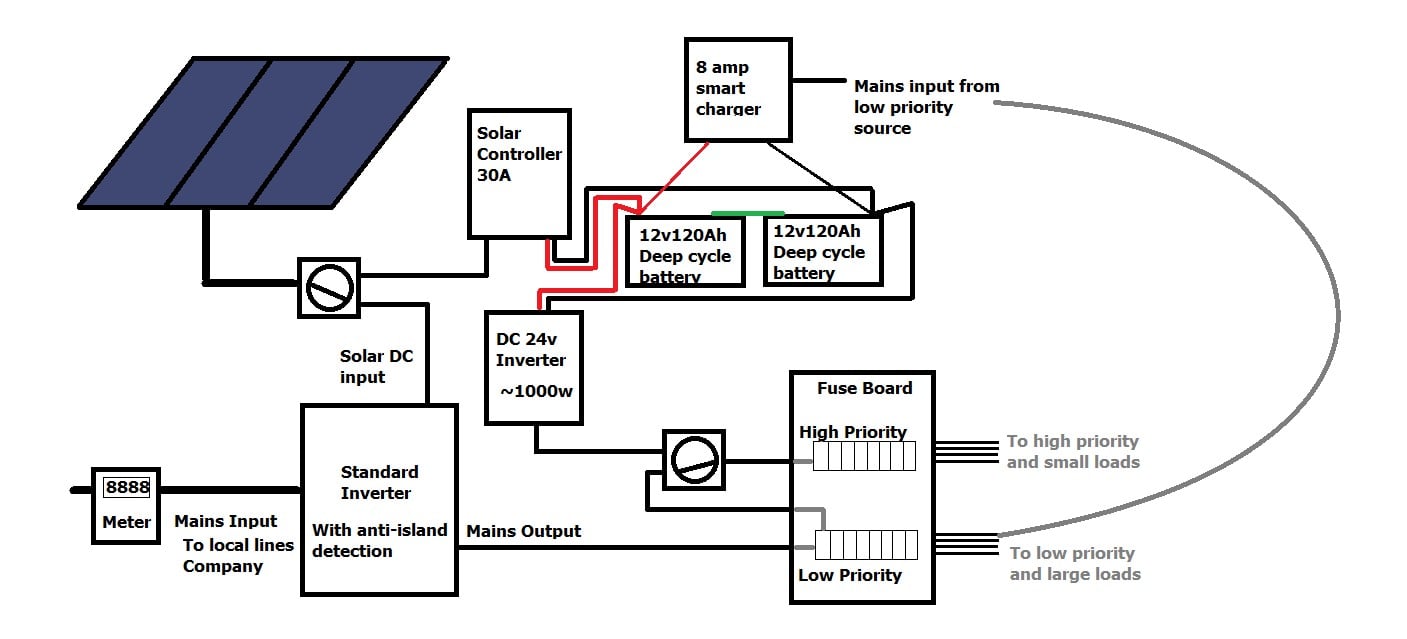raytaylor:
Here ya go fellas.
The goal is to have a very small secondary system that can provide mains power during a power cut.
1) A couple of deep cycle batteries are kept charged up by a standard smart charger. When they are charged up, it will keep them topped up by staying in a constant float mode.
2) When a power cut occurs, the solar panels are manually disconnected from the main inverter, and on to a small solar controller via the isolating switch. Something like a morningstar tristar MPPT 60A that will handle up to 600v input. Make sure the solar strings are configured for less than 600Voc and the solar controller is configured or stunted to only charge the batteries at an acceptable current. Eg for a pair of 120ah batteries in a string you only want to charge them at 10-15 amps.
3) The solar panels will be able to charge up the batteries and provide power to the small 12 or 24v inverter.
4) An isolating/input selector switch on the fuse board allows you to select the source of electricity for a few priority circuits. These may be the fridge, a single outlet in the office and another one in the lounge. The key being that we dont want these outlets to exceed the output capacity of the small inverter. Aside from the fridge, they would ideally be unused for anything else so you have to take appliances to the outlet if you want to use them during a power cut.
5) The small inverter will supply power to the priority outlets. The solar panels will be able to charge up the cheap low capacity deep cycle batteries each day via the small solar controller.
6) When mains power returns you can switch the priority outlets back to the main inverter, and the solar panels back over to supply the main inverter.
7) If the emergency batteries have not been charged up, the smart charger will do so from the mains supply via a low priority outlet (so you dont create a loop). It will keep them topped up indefinitley until you next need them.
For a low total cost of ownership, it would be best to use some standard sealed lead acid if they are only used occasionally.
Go with lithium like a tesla powerwall if you want to run the whole house or have it hooked up to the main inverter. But if its just an emergency system you are trying to create, for a small output to run a laptop/fridge/phone chargers, this solution should work and the sealed lead acid batteries dont cost much to replace every 5 years.
The only real issue I can see is the availability of 600VDC rated changeover switches. Normal isolating switches for that voltage are difficult and expensive enough on their own. I guess K&N or similar probably has parts that you can combine to make an interlocked pair of isolators, though.
Also, minor diagrammatic error; the mains does not pass through the grid-tie inverter; it's on a separate branch circuit.
Enphase's IQ8s do look interesting. It appears that islanding them requires a box which is essentially a safety contactor between the grid and your 'island'.
It is unclear whether they can operate completely standalone, or whether minimal battery capacity is required. If battery is required, then it's not usefully different from other systems except for the common bus being AC not battery.


